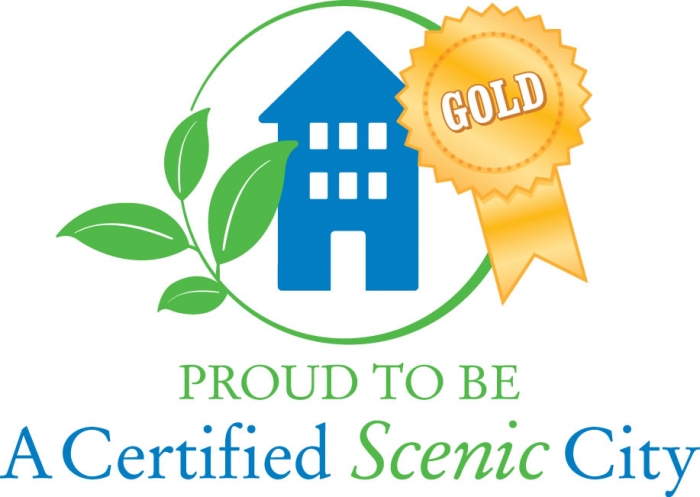Scenic City Gold awarded HSB

By Lew K. Cohn
Managing Editor
The Highlander
Horseshoe Bay is now the only city in either Llano or Burnet counties to hold the prestigious Gold Scenic City certification, it was announced at Tuesday's regular city council meeting.
Assistant city planner Nathalie Kip said the Scenic City Certification Program just this month informed the city of Horseshoe Bay it had been ranked up from Bronze to Gold after the city had submitted its recertification application in March.
“We've been with Scenic Cities program since 2010 and in 2015 were recertified as Bronze,” Kip said. “The way the program works, it is a five-year certification and at the two-year mark, cities have a chance to rank up. That's what we did this year, really highlighting the city's participation in the International Dark-Sky Association and the Mayor's Monarch Pledge.”
In doing so, the city went from scoring 226 points out of a possible 338 to 286 points, a gain of 60 points. This allowed the city to jump from Bronze to Gold certification and has placed the city just 18 points away from Platinum certification. Horseshoe Bay's Gold certification will be good until 2020, when the city will need to recertify again.
“It's absolutely wonderful,” Kip said of the accomplishment. “We wouldn't be having this recognition if it wasn't for council and city staff. It is a team effort. Our council is very supportive of our environmental efforts and the city's long-range plan speaks to several things that we listed on our application. It is a true collaboration.”
The Scenic City program supports and recognizes cities for commitment to high-quality scenic standards for public roadways and public spaces. To be recognized, a city must have a landscaping or tree-planting program, a system to issue on-premise sign permits and a prohibition of new billboards.
Cities apply to the program for a rigorous evaluation and scoring of existing municipal standards against the model. Those with the highest evaluation scores earn certification. Cities that qualify earn a five-year certification.
Cities are evaluated based on existing ordinance and code language in streetscapes; sign controls; parks, trails and open spaces; litter and graffiti prohibition; lighting standards; utility and cable line programs; design integrity; unique municipal features; landscaping and screening; and special programs.
There are five levels of certification: Platinum, Gold, Silver, Bronze and Recognized. Currently, there are 66 certified cities in Texas. The only other certified city in Llano or Burnet counties is Marble Falls, which holds a Bronze Scenic City certification.
“Scenic City Certification demonstrates a City’s commitment to improving quality of life, fostering civic pride, encouraging a sense of place, and boosting economic development,” said Claudia L. Williamson, director of business development for design firm PGAL and chair of the Scenic City Advisory Council. “Earning Scenic City certification drives smart planning which makes good business sense.”
“Through the Scenic City Certification Program, cities access a valuable diagnostic tool,” said Anne Culver, executive vice president of Scenic Texas. “A detailed 360° analysis of existing infrastructure standards supplies cities with a roadmap for future growth and development.”
Dark Sky
Horseshoe Bay was designated an International Dark Sky Community — only the eighth to have been designated as such in the United States and second in Texas — in November 2015 by the International Dark-Sky Association in recognition of its efforts to preserve naturally dark nighttime conditions.
Horseshoe Bay has no streetlights and no plans to install them except in specific instances where lighting is critical to public safety. Also, the city has no large “big box” retail outlets and no schools with sports lighting installations.
The city has implemented a program of outreach to residents and local homebuilders stressing the importance of dark skies and informing residents on how to comply with a modernized outdoor lighting code. It has also engaged with the Horseshoe Bay Property Owners' Association to spread information about the initiative.
Mayor's Monarch Pledge
In April 2016, the city adopted the National Wildlife Federation’s Mayors’ Monarch Pledge.
Through the pledge, the city’s chief executives commit to doing at least three of 25 actions recommended by NWF to help protection the annual migration of the monarch butterfly, which has sustained large losses in numbers in the last two decades.
Mayor Steve Jordan and Sondra Fox, a member of the Highland Lakes Master Naturalists, are leading the Horseshoe Bay effort.
The city is planting a monarch-friendly demonstration garden and adding milkweed and other nectar-producing plants in community gardens. It is also changing weed and mowing procedures to allow for native prairie and plant habitats while working with the public to encourage residents to plant monarch gardens at their homes and in their neighborhoods.
Monarch butterflies carry out an annual migration from Mexico to the U.S.-Canadian border and Central Texas is squarely in the path of a major monarch flyway. The journey begins each March as they leave wintering sites in Mexico and fly north to Texas and other southern states.
The monarchs lay eggs along the way and the new generations born there continue in a kind of multi-generational relay across the United States to locations in the northern U.S. and southern Canada. The return to Mexico, which involves only one generation of monarchs, begins in August.
Two decades ago more than 1 billion monarchs took part in the journey. The numbers have declined until only about 60 million made the trip in 2014.

